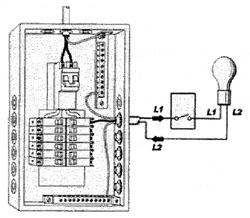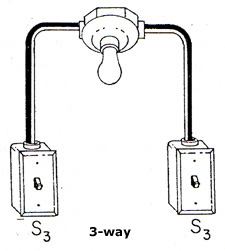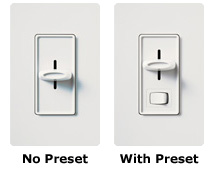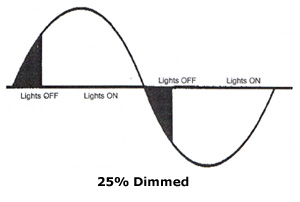Dimmers (either by themselves, or as part of a complete dimming system), switches, and controls can be a complicated topic. Let Del Mar Designs help you navigate through this topic.
Electrical Basics
You really don't think about electricity too much, unless you are an electrician. Just put a device into the wall, flip a switch, and it works. But knowing a few basics about electricity before you buy a dimmer can be helpful.
A circuit is a closed path of electricity.
It is sized by the breaker, but must have comparably sized wire.
Electrical current is measured in amps (A).
A typical older home gets 150-200 amps, a larger newer home may get double.
Volts (V) are the "pressure" in the current.
Most U.S. lighting and small appliances run on 110-120 volts.
Heavy appliances use 220-240 volts.
Volts can vary 5% up or down without a problem.
Watts (W) are electrical power. W = V x A.
Example: a 20 amp circuit at 120 volts supports 2400 watts.
You are billed base on kilowatt-hours (kWh, equal to 1000 watt-hours).
A 100-watt bulb operated for 10 hours is 1kWh.
Household wiring uses two conductors: hot and neutral.
Hot brings current to the load, neutral brings it back to close the circuit.
Both are "live". Switches and dimmers interrupt the hot conductor to operate.
The National Electric Code (NEC) requires lighting circuits be loaded to no more than 80% of rating.
Example: a 20-amp circuit should not support more than 16 amps, which is (16A x 120V =) 1920W.

What are the different types of switches?
A switch opens (interrupts) a circuit to turn off a light, or closes it to turn on a light. These are the different types of switches:
A single-pole switch controls lights from a single location.
A 3-way switch provides two separate control locations.
They are connected by an additional conductor called a traveler.
A 4-way switch provides for three or more dimmming locations.
Switches are wired to the "hot" conductor in a wall box.
Sometimes, the neutral conductor is not pulled into the box, sometimes it is.
Switches can control plug receptacles, used for portable lighting (lamps).
To dim a receptacle, you need a special device with a dedicated plug configuration.
Bathroom and Outdoors receptacles must be GFCI.
This is required by the NEC, and offers additional protection against shock.

Why Buy a Light Dimmer?
A Dimmer might seem like a hassle to install, and the dimmer may seem like it just makes your purchase more expensive, but that isn't true. Dimmers have many benefits, and can save you money in the long run.
| Cost Savings from Dimming | ||
| Light Level | Electricity Saved | Lamp Life |
| 90% | 10% | 2X |
| 75% | 20% | 4X |
| 50% | 40% | 20X |
| 25% | 60% | +20X |
Light Dimmers give you flexibility.
The same light fixture can be high intensity for tasks in the day, and low intensity for nights.
Treat a dimmer like a thermostat or a TV volume control.
Lighting can be as flexible as room temperature or noise volume.
Light Dimmers can enhance aesthetics.
They can balance multiple light sources and contract or refine highlights.
The dimmers themselves come in many colors to fit any room.
Light Dimmers are convenient and improve security.
They extend the life of light bulbs, requiring you to change bulbs less often.
Dimmers can also replace night lights and allow you turn on lights from multiple locations.
Light Dimmers can save you money.
Dimmed bulbs use less electricity, offering you monthly savings.
Dimmer Functions
There are 4 basic dimmer functions.
Adjustment: to adjust the intensity of light. Done with a knob, slide, or touch pad.
Presets: When you turn off the light, then turn it on, the dimmer remembers the intensity.
This is done with separate intensity controls and an on/off switch.
Remote / 3-Way: These allow you to control lights from more than 1 location.
Indicator Light: This makes it easy to locate in a dark room, or tell the difference between off and very dim.

Dimmers for Multiple Lights or High Wattage Lights
There are extra considerations with dimmers for high wattages (1000 watts and over), dimmers for low voltage fixtures, and multiple dimmers that share a faceplate (called ganging).
Dimmers are rated either in watts (W) or volt-amperes (VA). They are the same thing.
Low wattage (under 1000 watts) dissipate heat through metal mounting straps.
High wattage dimmers require large heat sinks to deal with the added heat that builds up.
Some dimmers have a two-gang heat sink, but these are for commercial use.
When using low voltage fixtures with integral transformers, add about 20% of the lamp wattage to account for transformer "losses".
When mounting two or more dimmers with a common faceplate, one of two different situations will occur:
You will have to break a heat sink or strap to make the dimmer fit.
Breaking the strap on one side will partially "derate" the dimmer.
Breaking both sides will fully "derate" the dimmer.
Partially derated dimmers have a lower wattage load.
Fully derated dimmers have an even lower wattage.
Do not try to estimate the reduced wattage available to you, consult the spec sheets.
Or you won't have to break a strap or heat sink to make the dimmer fit.
Dimmers will not be derated, you will have the full wattage available to you for each dimmer.
You may need custom, wider than standard wallplates.
You may need wider electrical backboxes.

How Dimmers Work
There is some confusion concerning how dimmers work, since early dimmers worked differently than modern dimmers. Dimmers for different types of light (incandescent, fluorescent) also work differently from each other.
Different light sources require different dimmers.
Don't use a low voltage dimmer on a 120 volt fixture.
Incandescent and halogen dimmers contain a switch called a "triac".
The triac turns the lights on and off 120 times a second.
The length of time the dimmer is on or off determines the brightness.
Adjust the dimmer with the knob, slider, or rocker to set the on/off time.
Older dimmers changed the resistance or voltage of the circuit.
Modern dimmers do not.
Fluorescent dimmers are more complex than halogen or incandescent dimmers.
These dimmers control special electronic dimming ballasts, and may use a separate interface.
Some fluorescent dimmers can dim down to 1% of output, but others dim only down to 10-20% of output.
Fluorescent dimmers save energy, but do NOT make the bulb last longer.

Dimmer Issues
You may run into issues when using dimmers.
All dimmers create noise. Whether or not it bothers you is a different issue.
Dimmers include filters to reduce the noise. Supplemental filters available to further reduce noise.
All dimmers are warm when the lights are on. If the dimmer is hot, consult an electrician.
Better dimmers allow for labels, useful if you have several fixtures that need dimming.
Better dimmers protect against some brief power surges. a "lightning arrestor" can protect the entire panel.





